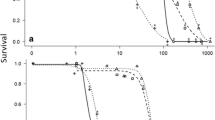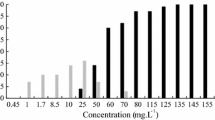Abstract
Pesticides with chlorpyrifos and endosulfan as active element are used for pest control on agricultural lands and are high-risk inputs in aquatic systems. The acute toxicity of these insecticides in the freshwater prawn Palaemonetes argentinus was evaluated. The results were used to determine the lowest observed–effect and no observed–effect concentrations. Individual growth of prawns in relation to chlorpyrifos and endosulfan exposure was analyzed. LC50 values to chlorpyrifos and endosulfan exposure were 2.98 µg L–1 and 14.10 at 24 hours and 0.49 µg L–1 and 6.28 µg L–1 at 96 hours of exposure, respectively. The size increment of prawns was the same in all treatments; cephalothorax length increased linearly per molt. The intermolt period was influenced by the toxic effect of pesticides during rearing time, and this decreased with the molt cycles compared with the normal growth pattern. The results suggest that juveniles of P. argentinus are sensitive to chlorpyrifos and endosulfan pollution.



Similar content being viewed by others
References
Arnold GL, Luckenbacha MW, Unger MA (2004) Runoff from tomato cultivation in the estuarine environment: Biologic effects of farm management practices. J Exp Mar Biol Ecol 298:323–346
Beltzer A (1983) Alimentación de la “garcita azulada” (Butorides striatus) en el valle aluvial del río Paraná Medio (Ciconiiformes: Ardeidae). Rev Hydrobiol Trop 16:203–206
Bhavan P, Zayapragassarazan Z, Geraldine P (1997) Acute toxicity tests of endosulfan and carbaryl for the freshwater prawn, Macrobrachium malcolmsonii (H. Milne Edwards). Pollut Res 16(1):5–7
Bhavan P, Geraldine P (2000) Aberrations in various parameters of bioenergetics in the prawn Macrobrachium malcolmsonii following exposure to endosulfan. Aquaculture 1:141–152
Bhavan P, Geraldine P (2001) Biochemical stress responses in tissues of the prawn Macrobrachium malcolmsonii on exposure to endosulfan. Pestic Biochem Physiol 70:27–41
Boschi EE (1981) Decapoda natantia. In: Fauna de agua dulce de la República Argentina. Volume 26. PROFADU, Buenos Aires, Argentina, pp 1–61
Camara de Sanidad Agropecuaria y Fertilizantes (2001) Guía de productos fitosanitarios para la República Argentina. Tomo I y II. Cámara de Sanidad Agropecuaria y Fertilizantes de la República, Buenos Aires, Argentina
Collins P, Petriella A (1996) Crecimiento y supervivencia del camarón Macrobrachium borellii (Decapoda: Palaemonidae) alimentado con dietas artificiales. Neotropica 42:3–8
Collins P, Petriella A (1999) Growth pattern of isolated prawn of Macrobrachium borellii (Crustacea, Decapoda, Palaemonidae). Invert Reptile Dev 36(1–3):87–91
Collins P, Cappello S (2006) Cypermethrin toxicity to aquatic life: Bioassays for the freshwater prawn Palaemonetes argentinus. Ach Environ Contam Toxicol 51:79–85
Collins P, Williner V, Giri F (2006) Trophic relationships in Crustacea Decapoda of a river with floodplain. In: Ashraf MTE (ed) Predation in organisms: A distinct phenomenon. Springer Verlag, Heidelberg, Germany, pp 59–86
Cushing CE, Allan JD (2001) Streams. Their ecology and life. Academic, Orlando, FL
Finney DJ (1971) Probit analysis. Cambridge University Press, New York, NY
Hartnoll RG (1982) Growth. In: Bliss DE (ed) The biology of crustacea. Volume 2. Academic, New York, NY, pp 111–196
Iriondo M (2004) The littoral complex at the Paraná mouth. Quatern Int 114:143–154
Jayachandran KV (2001) Palaemonid prawns. Biodiversity, taxonomy, biology and management. Science Publishers, New Hampshire
Jergentz S, Mugni H, Bonetto C, Schulz R (2005) Assessment of insecticide contamination in runoff and stream water of small agricultural streams in the main soybean area of Argentina. Chemosphere 61:817–826
Jergentz S, Pessacq P, Mugni H, Bonetto C, Schulz R (2004) Linking in situ bioassays and dynamics of macroinvertebrates to assess agricultural contamination in streams of the Argentine pampa. Ecotoxicol Environ Saf 59(2):133–141
Key PB, Chung KW, Opatkiewicz AD, Wirth EF, Fulton MH (2003) Toxicity of the insecticides fipronil and endosulfan to selected life stages of the grass shrimp (Palaemonetes pugio). Bull Environ Contam Toxicol 70:533–540
Lopretto E (1995) Crustacea eumalacostraca. In: Lopretto EC, Tell G (eds) Ecosistemas de aguas continentales. Metodologías para su estudio II. Ediciones Sur, La Plata, Argentina, pp 1001–1039
Lund SA, Fulton MH, Key PB (2000) The sensitivity of grass shrimp, Palaemonetes pugio, embryos to organophosphate pesticide induced acetylcholinesterase inhibition. Aquat Toxicol 48:127–134
Magalhães C, Bond-Buckup G, De Melo GA, Buckup L (2003) Manual de identificacao dos Crustacea Decapoda de água doce do Brasil. Museum de Zoologia, Universidade de São Paulo, São Paulo, Brasil
Montagna MC, Collins PA (2005) Toxicity of glyphosate on the freshwater prawn Palaemonetes argentinus. Nauplius 13(2):149–157
Moore MT, Huggett DB, Gillespie Jr WB, Rodgers Jr JH, Cooper CM (1998) Comparative toxicity of chlordane, chlorpyrifos, and aldicarb to four aquatic testing organisms. Arch Environ Contam Toxicol 34(2):152–157
Morrone JJ, Lopretto EC (1995) Parsimony analysis of endemicity of freshwater Decapoda (Crustacea: Malacostraca) from southern South America. Neotropica 41(105–106):3–8
Newman MC, Unger MA (2003) Fundamentals of ecotoxicology. CRC, Boca Raton, FL
Nobili G (1901) Decapodi raccolti del Dr. Filippo Silvestri nell’America meridionale. Bull Mus Zool Ant Comp Torino 16:1–16
Olima C, Pablo F (1997) Comparative tolerance of three populations of freshwater shrimp (Paratya australiensis) to the organophosphate pesticide, chlorpyrifos. Bull Environ Contam Toxicol 59(2):321–328
Oliva A, Ubeda CA, Vignes IE, Iriondo A (1981) Contribución al conocimiento de la ecología alimentaria del bagre amarillo (Pimelodus maculatus Lacépède 1803) del río de la Plata (Pisces, Pimelodidae). Comun Mus Argent Cienc Nat Ecol 1:31–50
Pennington PL, DeLorenzo ME, Lawton JC, Strozier ED, Fulton MH, Scott GI (2004) Modular estuarine mesocosm validation: Ecotoxicologic assessment of direct effects with the model compound endosulfan. J Exp Mar Biol Ecol 298:369–387
Renzulli P, Collins P (2000) Efecto de la temperatura en el crecimiento de Trichodactylus borellianus (Crustacea Eumalacostraca). FABICIB 4:129–136
Rodrigues Capitulo A (1984a) Efecto de los detergentes aniónicos sobre la supervivencia y tasa de metabolismo energético de Palaemonetes argentinus Nobili (Decapoda Natantia). Limnobios 2(8):549–555
Rodrigues Capitulo A (1984b) Incidencia del arsénico en parámetros biológicos de Palaemonetes argentinus Nobili (Decapoda Natantia). Limnobios 2(8):609–612
Schoettger RA (1970) Toxicology of thiodan in several fish and aquatic invertebrates. Invest Fish Control 35:1–31
Scott GI, Fulton MH, Moore DW, Wirth EF, Chandler GT, Key PB, et al. (1999) Assessment of risk decrease strategies for the management of agricultural nonpoint source pesticide runoff in estuarine ecosystems. Toxicol Ind Health 15:200–213
Selvakumar S, Geraldine P, Shanju S, Jayakumar T (2005) Stressor-specific induction of heat shock protein 70 in the freshwater prawn Macrobrachium malcolmsonii (H. Milne Edwards) exposed to the pesticides endosulfan and carbaryl. Pestic Biochem Physiol 82:125–132
Spivak ED (1997) Life history of a brackish-water population of Palaemonetes argentinus (Decapoda: Caridea) in Argentina. Ann Limnol 33(3):179–190
United States Environmental Protection Agency (1975) Methods for acute toxicity test with fish, macroinvertebrate, and amphibians. Ecol Res Ser EPA-660/3-75-009. Office of Water Regulations and Standards, Washington, DC
United States Environmental Protection Agency (1980) Ambient water quality criteria for endosulfan. EPA 440/5-80-046. Office of Water Regulations and Standards, Washington, DC
United States Environmental Protection Agency (1986a) Quality criteria for water 1986. EPA 440/5-86-001. Office of Water Regulations and Standards, Washington, DC
United States Environmental Protection Agency (1986b) Ambient water quality criteria for chlorpyrifos 1986. EPA 440/5-86-005. Office of Water Regulations and Standards, Washington, DC
Walker CH, Hopkin SP, Sibly RM, Peakall DB (2001) Principles of ecotoxicology. Taylor & Francis, London, UK
Wirth EF, Lund SA, Fulton MH, Scott GI (2002) Reproductive alterations in adult grass shrimp, Palaemonetes pugio, following sublethal, chronic endosulfan exposure. Aquat Toxicol 59:93–99
Wirth EF, Lund SA, Fulton MH, Scott GI (2001) Determination of acute mortality in adults and sublethal embryo responses of Palaemonetes pugio to endosulfan and methoprene exposure. Aquat Toxicol 53:9–18
Zar JH (1996) Biostatistical analysis. Prentice Hall, New York, NY
Acknowledgment
These studies were supported by Grant PICTO UNL N° 01-13232.
Author information
Authors and Affiliations
Corresponding author
Rights and permissions
About this article
Cite this article
Montagna, M.C., Collins, P.A. Survival and Growth of Palaemonetes argentinus (Decapoda; Caridea) Exposed to Insecticides with Chlorpyrifos and Endosulfan as Active Element. Arch Environ Contam Toxicol 53, 371–378 (2007). https://doi.org/10.1007/s00244-006-0209-x
Received:
Accepted:
Published:
Issue Date:
DOI: https://doi.org/10.1007/s00244-006-0209-x




